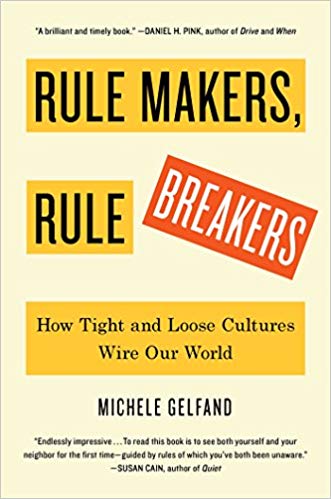You have /5 articles left.
Sign up for a free account or log in.
 Rule Makers, Rule Breakers: How Tight and Loose Cultures Wire Our World by Michele Gelfand
Rule Makers, Rule Breakers: How Tight and Loose Cultures Wire Our World by Michele Gelfand
Published in September of 2018.
Rule Makers, Rule Breakers is one of those books that will be easy critique without reading.
That is because this is one of those single big idea books. It follows along the same lines as Prius or Pickup? (Did you take the quiz?).
The big idea in Rule Makers, Rule Breakers is that tight and loose cultural norms explain almost everything about our world. Of course, the argument that Gelfand makes is infinitely more nuanced.
To illustrate tight and loose cultures, Gelfand riffs on a 2012 Slate article on Muppet Theory. This is a theory that argues the world is divided into two types of people: Chaos Muppets and Order Muppets. Chaos Muppets include Cookie Monster, Gonzo, Animal, and Ernie. Order Muppets are Bert, Scooter, Sam the Eagle, and of course Kermit the Frog.
What kind of Muppet are you?
Rule Makers, Rule Breakers explores why nations, regions, and individuals end up being Chaos Muppets (loose) or Order Muppets (tight).
The data shows that nations with tight cultural norms - think South Korea, Pakistan, Malaysia, Turkey, and China - tend to have histories marked by invasions, deprivation, and environmental disasters. Loose nations such as Brazil, the US, and New Zealand are likely to have abundant natural resources and less history of having their territories militarily threatened.
Within nations there are marked tight and loose divides. Rule Makers, Rule Breakers makes the argument that the Red State / Blue State divide is a tight/loose division. Trump voters were responding to economic and cultural threats that resulted in negative views about how the country is changing. Clinton voters believed that cultural and economic change is desirable.
Rule Makers, Rule Breakers may be one lens in which we can understand the traditional academic / IT divide.
Professors are Chaos Muppets. Administrative technology units have traditionally been the home of Order Muppets.
The professor Muppets want to use whatever technology they find most useful and easiest to implement. Administrative computing Muppets need to think about things like data security and systems reliability.
Chaos Muppets use Google Drive. Order Muppets recommend Sharepoint and Office 365. Chaos Muppets want to use their Macs. Order Muppets use Windows and fantasize about Thin Clients from Citrix.
The professor Muppets can’t understand why their computing choices should be constrained. The administrative computing Muppets understand the risks of viruses, data loss, and system downtime.
Fortunately, the world has mostly moved on (at least from what I can see) from this academic / IT divide. Technology trends (cloud services) have combined with educational trends (online and blended learning), to bring professors and technologists into closer alliance. Instructional designers code switch between the loose culture of faculty and the tight culture of IT, bridging the divisions. Plus, at some schools, a Chaos Muppet is the new Chief Information Officer.
I invite you to critique loose/tight theory, and by extension Rule Makers, Rule Breakers. The beauty of the book is not so much in the single big argument, but the way in which Gelfand patiently builds up and then applies the theory.
We might argue that the world is not as simple as a single framework can explain, but even simple ideas when applied to attempts to answer big questions can make for fascinating reading.
Go ahead and read Rule Makers, Rule Breakers and come back and tell us if Gelfand isn’t on to something.
What big idea book might you recommend?
What are you reading?




